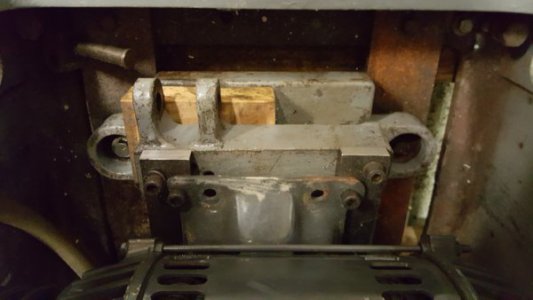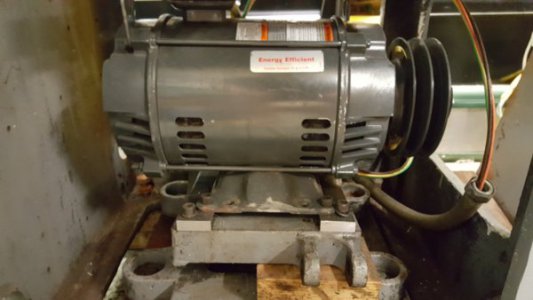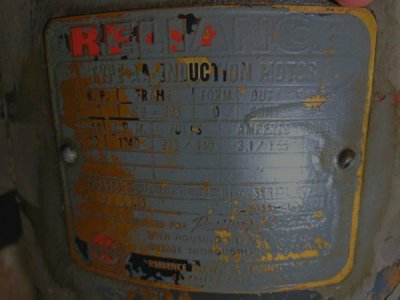- Joined
- Dec 18, 2013
- Messages
- 87
I think you know everything is relative, especially in the machinist trade.
Actually the best description I've heard is the only thing two machinists can agree on is the third one is an idiot.
I think you know everything is relative, especially in the machinist trade.
You don't mention if you have a good coolant system on your 15", but if you do and your set up is rigid, you will be missing a bet if you don't learn how to grind lipped cutting tools from HSS. For brute metal removal rates with the RPM range you state, they can't be beat, and they produce an acceptable finish with coolant. They are all we used before carbide and high RPM gigahorsepower lathes were common. The difference is that the removed metal comes off as a tightly coiled ribbon rather than as a chip that's breaking up and coolant flow is essential. The depth of cut can be 3/8" to 1/2" per pass depending on horsepower.
A 1946 LeBlond wasn't really designed for carbide so the high speed and the horsepower rating is for HSS, and back then, they were using CS. The high speeds devolped would be on tall gears so pushing a carbide cutter into the work surface would be based on HP. Working in reverse, the SFPM would slow and the quality of cut would go downhill also. Without knowing what horsepower the lathe has or the SFPM it can maintain, I was simply stating that HP comes into play.
I have a vintage Lodge & Shipley that I don't as yet know the age so I've spent a lot of time looking at the old machines. My father-in-law who gave me the lathe, purchased it sometime in the early 1950's. His 40+ year machinist career started in the early 1930's. When he gave me the 2-gal. can of misc. HSS and carbide cutters he explained the pros and cons. The cons for the carbide cutters are primarily the speed and feed rates required. At slow speeds the heat isn't transfered to the chip so it builds up in the work. The carbide inserts work better than the brazed tooling because they have a smaller surface and a built in chip breaker.
I'm not comparing my lathe to the LeBlonde because they are two diffrent machines with decades between their production. I think you know everything is relative, especially in the machinist trade. In regards to may comment, we can start with the quality of the carbide cutter. In 1946 the LeBlond operators manual was mentioning carbide as a cutter with minimum instructions on material-speed-feed etc. -Russ
There's no need to deflect and bring the plumber into this.Actually the best description I've heard is the only thing two machinists can agree on is the third one is an idiot.
In regards to more HP, I would lean that direction if there is protection for for the head. i.e. shear pins etc. Some HP ratings have changed. I would suggest taking the motor to a shop or see if they are willing to part with expertise at to the direction you take. What type of lubrication does the motor use, oil, grease, and what type of seals. Are the windings, armature open or enclosed. Replacing the seals may be an easy and inexpensive fix.I do not have a coolant system. Definitely have thought about adding one at some point.
This thing still has the original 1hp 203 frame 3 phase motor and it still worksHowever the seals on it are bad and it leaks oil/grease like crazy. I'd like to get a new motor on it eventually, but I can't find any motor frame adapters for that frame. Not sure if it would be advisable to get a higher HP motor or not.
I've replaced many old motors with newer ones on machine tools over the years. You have to forget the old frame sizes and adapt the old motor base to accept the new motor. I just did one the other day on my 15" Sheldon lathe. Don't remember the original frame size, but had to mount a couple of pieces of 1/2 x 2 flat bar to the old base with new holes in place to mount the newer 182/184T frame motor. (Just realized this is off topic. Sorry!)This thing still has the original 1hp 203 frame 3 phase motor and it still worksHowever the seals on it are bad and it leaks oil/grease like crazy. I'd like to get a new motor on it eventually, but I can't find any motor frame adapters for that frame. Not sure if it would be advisable to get a higher HP motor or not.


Maybe you can find a manual or sales brochure at Vintage Machinery . org to see what hp motors were originally available for your lathe.
In regards to more HP, I would lean that direction if there is protection for for the head. i.e. shear pins etc. Some HP ratings have changed. I would suggest taking the motor to a shop or see if they are willing to part with expertise at to the direction you take. What type of lubrication does the motor use, oil, grease, and what type of seals. Are the windings, armature open or enclosed. Replacing the seals may be an easy and inexpensive fix.
I've replaced many old motors with newer ones on machine tools over the years. You have to forget the old frame sizes and adapt the old motor base to accept the new motor. I just did one the other day on my 15" Sheldon lathe. Don't remember the original frame size, but had to mount a couple of pieces of 1/2 x 2 flat bar to the old base with new holes in place to mount the newer 182/184T frame motor. (Just realized this is off topic. Sorry!)

A book on how to run a lathe will often cover many different models, and so will not show the details for them all. Do you have a parts or operation manual for your lathe? Do you know the model number of it?I have the "Running a Regal" from the model years of my lathe, but I did not see any motor ratings anywhere in the manual.
